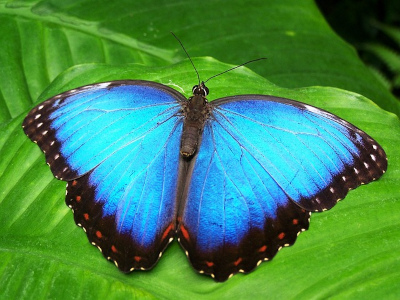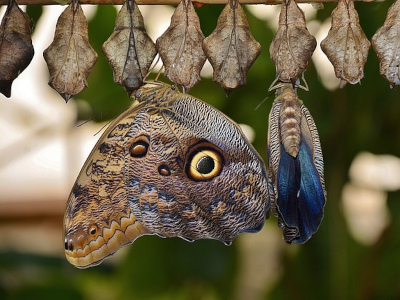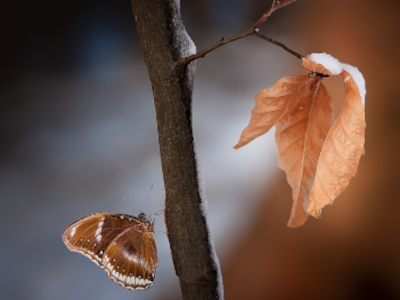Butterflies are insects that belong to the group Lepidoptera, which also includes moths. The name “Lepidoptera” comes from Greek and means “scaly wings,” which is fitting because butterflies’ wings are covered in tiny scales. These scales form colorful patterns unique to each species, giving butterflies their beauty. In addition to their wings, butterflies have six legs, three body parts (head, thorax, and abdomen), two antennae, and an exoskeleton.
Life cycle
The life cycle of a butterfly consists of four stages: egg, larva, pupa, and adult. The journey begins with the tiny butterfly eggs, which are attached to leaves or stems by the female butterfly. From these eggs, caterpillars hatch and enter the larva stage. During this stage, caterpillars eat constantly and shed their old skin multiple times.
The pupa, or chrysalis, is the third stage of the life cycle. The caterpillar attaches itself to a support, and the chrysalis is revealed when its exoskeleton splits open. The chrysalis hangs down until the butterfly transformation is complete. Although it may appear motionless, inside the chrysalis, the caterpillar’s structure is broken down and rearranged into the wings, body, and legs of the adult butterfly. The pupa does not eat but obtains energy from the food consumed during the larval stage. The duration of the pupal stage varies depending on the species, ranging from a few days to over a year. Some butterfly species spend the winter or hibernate as pupae.
The adult stage is the fourth and final stage of the life cycle. Once the chrysalis casing splits, the butterfly emerges. It will eventually mate and lay eggs to start the cycle again. Most adult butterflies have a lifespan of only one to two weeks, although a few species can live up to 18 months.
Butterfly activities
Butterflies have a variety of activities in their daily lives, which include:
Feeding: Caterpillars are picky eaters and stay on the same plant or leaf. Adult butterflies prefer flower nectar but may also feed on other liquids like rotting fruit or tree ooze. They like to feed in sunny areas protected from wind.
Basking: Butterflies rely on external sources to regulate their body temperature. When it gets too cold, they can’t fly until they warm up their muscles. If it gets too chilly, they bask in the sun with their wings spread out to absorb heat.
Puddling: Butterflies may seek shade or cool spots like puddles when they get too hot. More males than females puddle, as the salts and nutrients in the water are important for mating.
Patrolling and perching: Male butterflies have two ways to find a female mate. They can either patrol an area where other butterflies are active or perch on a tall plant in an area where females might be.
Mating: When a male spots a potential mate, it will fly closer, releasing special chemicals called pheromones. The male may also perform a unique “courtship dance” to attract the female. If she is interested, they will mate by joining together end to end. The male passes sperm to the female during mating, fertilizing the eggs. The male butterfly usually dies shortly after mating.
Egg-laying: After mating, the female butterfly seeks out a specific plant to lay her eggs. She chooses a plant based on the leaf color and shape. She may tap the leaf with her feet to release a plant odor before laying her fertilized eggs. The female butterfly can lay a single egg or lay them in clusters using a sticky substance to attach the eggs to leaves or stems.
Hibernating: To survive the cold weather, butterflies hibernate in safe places. They choose locations such as the peeling bark of trees, perennial plants, logs, or old fences as their winter hideouts. While they can hibernate at any stage of their life cycle, typically each species is dormant for only one stage.
Migrating: Butterflies can avoid cold weather by migrating to warmer regions. Some butterflies only travel a short distance. However, the monarch butterfly is known for its long-distance migration. Only a few of the original adult monarchs actually make it back home. Instead, the females mate and lay eggs along the way, and their offspring finish the migration.
Camouflage: Butterflies and caterpillars are hunted by various animals, including birds, spiders, and lizards. They are not very good at defending themselves against these predators, so they have come up with different ways to protect themselves. One way is by using camouflage to make themselves blend in and be hard to see. Caterpillars can have colors or structures that help them disappear into their surroundings. The wings of butterflies can also help them blend in. When they are resting with their wings closed, some butterflies look like dead leaves on a twig.
Sources:
https://www.uky.edu/hort/butterflies/all-about-butterflies



